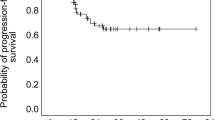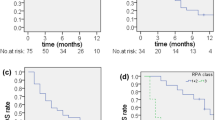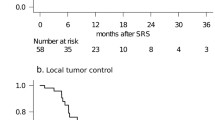Abstract
Bevacizumab blocks the effects of vascular endothelial growth factor in leakage-prone capillaries and has been suggested as a new treatment for cerebral radiation edema and necrosis. CyberKnife is a new, frameless stereotactic radiosurgery system. This work investigated the safety and efficacy of CyberKnife followed by early bevacizumab treatment for brain metastasis with extensive cerebral edema. The eligibility criteria of the patients selected for radiosurgery followed by early use of adjuvant bevacizumab treatment were: (1) brain tumors from metastasis with one solitary brain lesion and symptomatic extensive cerebral edema; (2) >18 years of age; (3) the patient refused surgery due to the physical conditions and the risk of surgery; (4) no contraindications for bevacizumab. (5) bevacizumab was applied for a minimum of 2 injections and a maximum of 6 injections with a 2-week interval between treatments, beginning within 2 weeks of the CyberKnife therapy; (6) Karnofsky performance status (KPS) ≥30. Tumor size and edema were monitored by magnetic resonance imaging (MRI). Dexamethasone dosage, KPS, adverse event occurrence and associated clinical outcomes were also recorded. Eight patients were accrued for this new treatment. Radiation dose ranged from 20 to 33 Gy in one to five sessions, prescribed to the 61–71 % isodose line. Bevacizumab therapy was administered 3–10 days after completion of CyberKnife treatment for a minimum of two cycles (5 mg/kg, at 2-week intervals). MRI revealed average reductions of 55.8 % (post-gadolinium) and 63.4 % (T2/FLAIR). Seven patients showed significant clinical neurological improvements. Dexamethasone was reduced in all patients, with five successfully discontinuing dexamethasone treatment 4 weeks after bevacizumab initiation. Hypertension, a bevacizumab-related adverse event, occurred in one patient. After 3–8 months, all patients studied were alive and primary brain metastases were under control, 2 developed new brain metastases and underwent salvage CyberKnife treatment. Recurrent edema and emerging radiation necrosis were not observed. CyberKnife radiosurgery followed by early use of bevacizumab is promising and appears safe for treatment of brain metastases with extensive cerebral edema.

Similar content being viewed by others
References
Soffietti R, Ruda R, Trevisan E (2008) Brain metastases: current management and new developments. Curr Opin Oncol 20:676–684. doi:10.1097/CCO.0b013e32831186fe
Müller-Riemenschneider F, Bockelbrink A, Ernst I, Schwarzbach C, Vauth C, von der Schulenburg J, Willich SN (2009) Stereotactic radiosurgery for the treatment of brain metastases. Radiother Oncol 91:67–74
Kaal EC, Vecht CJ (2004) The management of brain edema in brain tumors. Curr Opin Oncol 16:593–600
Grände P-O, Romner B (2012) Osmotherapy in brain edema: a questionable therapy. J Neurosurg Anesthesiol 24:407–412
Dietrich J, Rao K, Pastorino S, Kesari S (2011) Corticosteroids in brain cancer patients: benefits and pitfalls. Expert Rev Clin Pharmacol 4:233–242
Shuto T, Matsunaga S, Inomori S, Fujino H (2008) Efficacy of gamma knife surgery for control of peritumoral oedema associated with metastatic brain tumours. J Neurol Neurosurg Psychiatry 79:1061–1065
Varlotto JM, Flickinger JC, Niranjan A, Bhatnagar AK, Kondziolka D, Lunsford LD (2003) Analysis of tumor control and toxicity in patients who have survived at least one year after radiosurgery for brain metastases. Int J Radiat Oncol Biol Phys 57:452–464
Ohguri T, Imada H, Kohshi K, Kakeda S, Ohnari N, Morioka T, Nakano K, Konda N, Korogi Y (2007) Effect of prophylactic hyperbaric oxygen treatment for radiation-induced brain injury after stereotactic radiosurgery of brain metastases. Int J Radiat Oncol Biol Phys 67:248–255
Pan HC, Sun MH, Chen CC, Chen CJ, Lee CH, Sheehan J (2008) Neuroimaging and quality-of-life outcomes in patients with brain metastasis and peritumoral edema who undergo Gamma Knife surgery. J Neurosurg 109 (Suppl):90–98
Dvorak HF, Sioussat TM, Brown LF, Berse B, Nagy JA, Sotrel A, Manseau EJ, Van De Water L, Senger DR (1991) Distribution of vascular permeability factor (vascular endothelial growth factor) in tumors: concentration in tumor blood vessels. J Exp Med 174:1275–1278
Li YQ, Ballinger JR, Nordal RA, Su ZF, Wong CS (2001) Hypoxia in radiation-induced blood-spinal cord barrier breakdown. Cancer Res 61:3348–3354
Gonzalez J, Kumar AJ, Conrad CA, Levin VA (2007) Effect of bevacizumab on radiation necrosis of the brain. Int J Radiat Oncol Biol Phys 67:323–326
Torcuator R, Zuniga R, Mohan YS, Rock J, Doyle T, Anderson J, Gutierrez J, Ryu S, Jain R, Rosenblum M (2009) Initial experience with bevacizumab treatment for biopsy confirmed cerebral radiation necrosis. J Neurooncol 94:63–68
Boothe D, Young R, Yamada Y, Prager A, Chan T, Beal K (2013) Bevacizumab as a treatment for radiation necrosis of brain metastases post stereotactic radiosurgery. Neuro Oncol 15:1257–1263
Levin VA, Bidaut L, Hou P, Kumar AJ, Wefel JS, Bekele BN, Prabhu S, Loghin M, Gilbert MR, Jackson EF (2011) Randomized double-blind placebo-controlled trial of bevacizumab therapy for radiation necrosis of the central nervous system. Int J Radiat Oncol Biol Phys 79:1487–1495
Macdonald DR, Cascino TL, Schold S, Cairncross JG (1990) Response criteria for phase II studies of supratentorial malignant glioma. J Clin Oncol 8:1277–1280
Rush S, Elliott RE, Morsi A, Mehta N, Spriet J, Narayana A, Donahue B, Parker EC, Golfinos JG (2011) Incidence, timing, and treatment of new brain metastases after Gamma Knife surgery for limited brain disease: the case for reducing the use of whole-brain radiation therapy. J Neurosurg 115:37–48. doi:10.3171/2011.2.jns101724
Kalkanis SN, Kondziolka D, Gaspar LE, Burri SH, Asher AL, Cobbs CS, Ammirati M, Robinson PD, Andrews DW, Loeffler JS (2010) The role of surgical resection in the management of newly diagnosed brain metastases: a systematic review and evidence-based clinical practice guideline. J Neurooncol 96:33–43
Shimamoto S, Inoue T, Shiomi H, Sumida I, Yamada Y, Tanaka E (2002) CyberKnife stereotactic irradiation for metastatic brain tumors. Radiat Med 20:299
Calcerrada Díaz-Santos N, Blasco Amaro JA, Cardiel GA, Andradas Aragonés E (2008) The safety and efficacy of robotic image-guided radiosurgery system treatment for intra-and extracranial lesions: a systematic review of the literature. Radiother Oncol 89:245–253
Wong ET, Huberman M, Lu X-Q, Mahadevan A (2008) Bevacizumab reverses cerebral radiation necrosis. J Clin Oncol 26:5649–5650
Gutin PH, Iwamoto FM, Beal K, Mohile NA, Karimi S, Hou BL, Lymberis S, Yamada Y, Chang J, Abrey LE (2009) Safety and efficacy of bevacizumab with hypofractionated stereotactic irradiation for recurrent malignant gliomas. Int J Radiat Oncol Biol Phys 75:156–163
Wang Y, Pan L, Sheng X, Mao Y, Yao Y, Wang E, Zhang N, Dai J (2012) Reversal of cerebral radiation necrosis with bevacizumab treatment in 17 Chinese patients. Eur J Med Res 17:25. doi:10.1186/2047-783X-17-25
Sanborn MR, Danish SF, Rosenfeld MR, O’Rourke D, Lee JY (2011) Treatment of steroid refractory, gamma knife related radiation necrosis with bevacizumab: case report and review of the literature. Clin Neurol Neurosurg 113:798–802. doi:10.1016/j.clineuro.2011.08.007
Furuse M, Kawabata S, Kuroiwa T, Miyatake S-I (2011) Repeated treatments with bevacizumab for recurrent radiation necrosis in patients with malignant brain tumors: a report of 2 cases. J Neurooncol 102:471–475
Conflict of interest
The authors declare that they have no conflicts of interest in the research.
Author information
Authors and Affiliations
Corresponding author
Rights and permissions
About this article
Cite this article
Wang, Y., Wang, E., Pan, L. et al. A new strategy of CyberKnife treatment system based radiosurgery followed by early use of adjuvant bevacizumab treatment for brain metastasis with extensive cerebral edema. J Neurooncol 119, 369–376 (2014). https://doi.org/10.1007/s11060-014-1488-0
Received:
Accepted:
Published:
Issue Date:
DOI: https://doi.org/10.1007/s11060-014-1488-0




